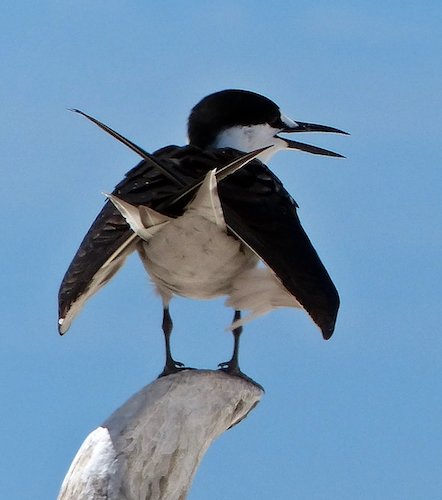Territory of the Cocos (Keeling) Islands

Birding the Cocos Islands
The Territory of the Cocos (Keeling) Islands, also called Cocos Islands and Keeling Islands, is a territory of Australia, located in the Indian Ocean, southwest of Christmas Island and approximately midway between Australia and Sri Lanka.
The territory consists of two atolls and 27 coral islands, of which two, West Island and Home Island, are inhabited with a total population of approximately 600.
The Cocos (Keeling) Islands consist of two flat, low-lying coral atolls with an area of 14.2 square kilometres (5.5 sq mi), 26 kilometres (16 mi) of coastline, a highest elevation of 5 metres (16 ft) and thickly covered with coconut palms and other vegetation. The climate is pleasant, moderated by the southeast trade winds for about nine months of the year and with moderate rainfall. Cyclones may occur in the early months of the year.
North Keeling Island is an atoll consisting of just one C-shaped island, a nearly closed atoll ring with a small opening into the lagoon, about 50 metres (160 ft) wide, on the east side. The island measures 1.1 square kilometres (270 acres) in land area and is uninhabited. The lagoon is about 0.5 square kilometres (120 acres). North Keeling Island and the surrounding sea to 1.5 km (0.93 mi) from shore form the Pulu Keeling National Park, established on 12 December 1995. It is home to the only surviving population of the endemic, and endangered, Cocos Buff-banded Rail.
South Keeling Islands is an atoll consisting of 24 individual islets forming an incomplete atoll ring, with a total land area of 13.1 square kilometres (5.1 sq mi). Only Home Island and West Island are populated. The Cocos Malays maintain weekend shacks, referred to as pondoks, on most of the larger islands.
As a small and isolated group of islands in two atolls 24 km apart in the eastern Indian Ocean, the number of species of resident landbirds (as opposed to seabirds and waders) is very small. These comprise the endemic subspecies of buff-banded rail, the introduced green junglefowl and helmeted guineafowl, the white-breasted waterhen, eastern reef egret, nankeen night heron and the introduced Christmas white-eye. Four other introduced species are now extinct in the Islands. Several other landbird species have been recorded occasionally, but none has established a breeding population.
Migratory waders recorded in the islands include some regular visitors as well as vagrants. None breeds there. However, North Keeling is important for breeding seabirds, with sizeable numbers of red-footed boobies, great and lesser frigatebirds, common noddies and white terns. Other breeding seabirds include wedge-tailed shearwaters, masked boobies, brown boobies, red-tailed and white-tailed tropicbirds, and sooty terns. It is possible that the herald petrel breeds there as well.
Presumably, before human occupation of the islands in the 19th century, seabirds bred on both atolls. However, with the establishment of a human population and the introduction of rodents to the southern atoll, significant seabird colonies are now restricted to the northern atoll of North Keeling. Although the Cocos islanders used to visit North Keeling regularly to harvest seabirds, this practice largely ceased with the establishment of Pulu Keeling National Park in 1995.
-
Number of bird species: 90
Several species on the list are extinct and the overwhelming majority have been vagrant birds. There are only 19 breeding birds at least half a dozen of which are introduced species. There are also around 8 regular visitors.
Number of endemics: 1 (Sub-species)
Cocos Buff-banded Rail Gallirallus philippensis andrewsi
-
Birding Tours Australia
Tour OperatorBirding Tours Australia are the experts when it comes to birds and Cocos knowing the locations of the key Cocos specialities such as Green Junglefowl, Western Reef Egret, White Breasted Waterhen, Saunders's Tern and having discovered more rare vagrant species on these islands than anyone else. A pristine lagoon encircled by tiny coral atolls, Richard Baxter of Birding Tours Australia has rediscovered this island paradise as a key location for encounters of rare vagrant species.
-
Birdwatching Cocos
ArticleThe Cocos Keeling Islands offer the avid birdwatcher the chance to combine sightings of 39 breeding or resident bird species with an iconic and remote tropical island experience. Unforgettable! The Cocos Keeling Islands intercept the southwest extremity of the East Asian - Australian flyway. Migratory shorebirds are the most travelled migrants, following the sun on their 25,000 km annual round trip from the Arctic Circle through South-East Asia and Australia to New Zealand. The non-breeding cycle, which takes place in the southern hemisphere, occurs from September to April. -
Christmas & Cocos Keeling Islands Birding Guide
PDF BrochurePDF Brochure - Your essential guide to birding on the islands. -
Fauna of the Cocos (Keeling) Islands
InformationAs a small and isolated group of islands in two atolls 24 km apart in the eastern Indian Ocean, the number of species of resident landbirds (as opposed to seabirds and waders) is very small. These comprise the endemic subspecies of buff-banded rail, the introduced green junglefowl and helmeted guineafowl, the white-breasted waterhen, eastern reef egret, nankeen night heron and the introduced Christmas white-eye. Four other introduced species are now extinct in the Islands. Several other landbird species have been recorded occasionally, but none has established a breeding population.
